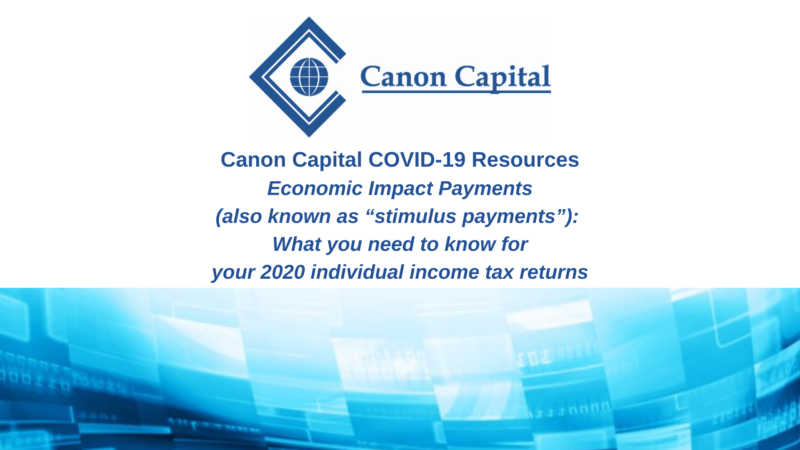To say that there have been many tax changes throughout this unprecedented time would be an understatement. One of the most misunderstood of these changes is the Economic Impact Payments program, which you might have heard referred to in the media as “stimulus payments.” Economic Impact Payments and stimulus payments are one and the same.
As a result of pandemic relief legislation signed into law in 2020, there were two rounds of Economic Impact Payments during the year. These payments could have been in the form of a direct deposit, a check, or a debit card, all sent out by the US Treasury. The first round of payments began in April of 2020 and continued through July of 2020. The second round of payments began at the end of December of 2020 and continued into January of 2021.
If you are one of our individual 1040 tax clients, you will note that our tax checklist for this year includes the following question: “Did you receive an Economic Impact Payment?” to which you might have answered, “No.”. Given the confusion regarding the language referring to these payments, if the question had been worded like this: “Did you receive a stimulus payment?” you might have answered, “Yes.”.
Please consider this question carefully as it is important that tax preparers have correct information with which to prepare your return. If you in fact received these payments in 2020 you will need to provide the amount of both payments you received. The Economic Impact Payments are advance credits against your 2020 taxes. It is imperative that your tax preparers have this information to prepare a correct tax return for you for the 2020 tax year.
The Internal Revenue Service sent out a Notice 1444 letter for the first round of payments telling you what your payment amount was. If you received a second payment you will eventually receive a Notice 1444-B letter but in the meantime, you will need to find this information in your personal records.
To determine if you were eligible for the payments please consult the following guidelines:
- If you filed Married Filing Joint in 2019 and your Adjusted Gross Income (AGI) was between $0 through $150,000 you should have received $2,400 for yourself and spouse. In addition, any dependent under the age of 17 would have qualified for an additional $500 apiece. If your AGI was above $150,000 through $198,000 you would have qualified for a partial payment. For the second payment the same income guidelines apply but the amount was $600 per person whether taxpayers or dependents.
- If you filed as Single in 2019 and your Adjusted Gross Income (AGI) was between $0 through $75,000 you should have received $1,200 for yourself. In addition, any dependent under the age of 17 would have qualified for an additional $500 apiece. If your AGI was above $75,000 through $99,000 you would have qualified for a partial payment. For the second payment the same income guidelines apply but the amount was $600 per person whether taxpayer’s or dependents.
- If you filed as Head of Household in 2019 and your Adjusted Gross Income (AGI) was between $0 through $112,500 you should have received $1,200 for yourself. In addition, any dependent under the age of 17 would have qualified for an additional $500 apiece. If your AGI was above $112,500 through $136,500 you would have qualified for a partial payment. For the second payment the same income guidelines apply but the amount was $600 per person whether taxpayer’s or dependents.
- Keep in mind for the first round of payments, if your 2019 return wasn’t filed yet, the IRS would have looked to your 2018 tax return for adjusted gross income numbers.
If you have any questions, please do not hesitate to contact us.

